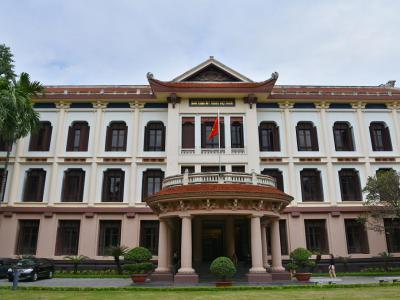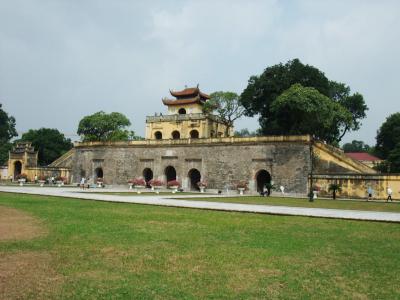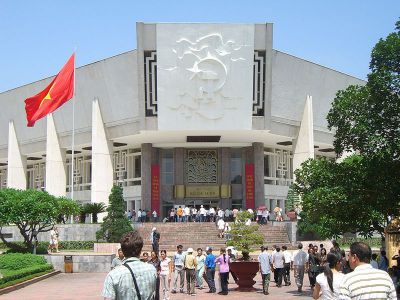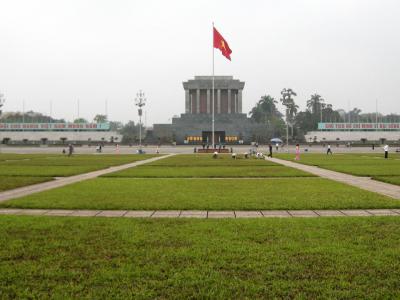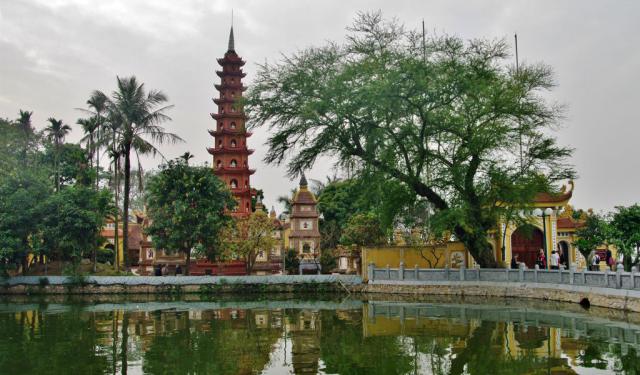
Hanoi Introduction Walking Tour (Self Guided), Hanoi
Known for its centuries-old architecture and rich culture with Southeast Asian, Chinese and French influences, the capital of Vietnam, Hanoi, traces its origin back to the third century BC. Originally, a portion of modern-day Hanoi served as the capital of the historic Vietnamese nation Âu Lạc. Following the collapse of Âu Lạc, the city was made part of Han China (111 BC-40 AD).
Throughout its history, Hanoi has gone by different names including Long Biên ("Dragon Edge"), Tống Bình ("Song Peace") and Long Đỗ ("Dragon Belly"). The word long ("dragon") here is associated with the Red River which curves around the city, resembling a dragon.
In 866, the town was turned into a citadel named Đại La ("Big Net"). In 1010, Vietnamese emperor Lý Thái Tổ established his capital on the territory of present-day downtown, calling it Thăng Long ("Ascending Dragon"). During the Lê dynasty (1428-1789), the city was known as Đông Kinh ("Eastern Capital"), the name which had eventually transformed to Tonkin. Finally, in 1831, emperor Minh Mạng renamed it Hà Nội (which means "Between the Rivers") which has remained the city's official name ever since.
Hanoi is also sometimes dubbed "Paris of the East" for its French-style tree-fringed boulevards, dozens of lakes and thousands of French colonial-era buildings, all of which make it a popular tourist destination.
The city served as the capital of French Indochina from 1887 until the mid 1940s. During WWII, from 1940 to 1945, it was occupied by the Imperial Japanese forces and then briefly became the seat of the Việt Minh government after Ho Chi Minh declared the independence of Vietnam. The French reoccupied the city again in 1946, and after years of fighting between them and the Viet Minh forces (First Indochina War, 1946–1954) it had finally become the capital of independent North Vietnam, in 1954. Following the end of the Vietnam War (1955–1975) and reunification of North and South Vietnam, Hanoi became the capital of the Socialist Republic of Vietnam, on 2 July 1976.
The central Ba Đình district holds a high concentration of government headquarters, including the Presidential Palace, and the monumental Ho Chi Minh Mausoleum. Also here, juxtaposed with French colonial architecture, are a number of prominent imperial sites like the Temple of Literature (1070), the One Pillar Pagoda (1049), and the Flag Tower of Hanoi (1812). In 2004, a massive part of the 900-year-old Imperial Citadel of Thăng Long — currently a UNESCO World Heritage Site — was discovered near Ba Đình Square. Hanoi also hosts a number of cultural venues, such as the National Museum of Fine Arts.
If you wish to learn more about the region that has been continuously inhabited for the past 4,000 years and explore the crowded streets of the Vietnamese capital lined with prominent landmarks and, perhaps, discover some cute hidden gems along the way, too, take this self-guided introductory walk.
Throughout its history, Hanoi has gone by different names including Long Biên ("Dragon Edge"), Tống Bình ("Song Peace") and Long Đỗ ("Dragon Belly"). The word long ("dragon") here is associated with the Red River which curves around the city, resembling a dragon.
In 866, the town was turned into a citadel named Đại La ("Big Net"). In 1010, Vietnamese emperor Lý Thái Tổ established his capital on the territory of present-day downtown, calling it Thăng Long ("Ascending Dragon"). During the Lê dynasty (1428-1789), the city was known as Đông Kinh ("Eastern Capital"), the name which had eventually transformed to Tonkin. Finally, in 1831, emperor Minh Mạng renamed it Hà Nội (which means "Between the Rivers") which has remained the city's official name ever since.
Hanoi is also sometimes dubbed "Paris of the East" for its French-style tree-fringed boulevards, dozens of lakes and thousands of French colonial-era buildings, all of which make it a popular tourist destination.
The city served as the capital of French Indochina from 1887 until the mid 1940s. During WWII, from 1940 to 1945, it was occupied by the Imperial Japanese forces and then briefly became the seat of the Việt Minh government after Ho Chi Minh declared the independence of Vietnam. The French reoccupied the city again in 1946, and after years of fighting between them and the Viet Minh forces (First Indochina War, 1946–1954) it had finally become the capital of independent North Vietnam, in 1954. Following the end of the Vietnam War (1955–1975) and reunification of North and South Vietnam, Hanoi became the capital of the Socialist Republic of Vietnam, on 2 July 1976.
The central Ba Đình district holds a high concentration of government headquarters, including the Presidential Palace, and the monumental Ho Chi Minh Mausoleum. Also here, juxtaposed with French colonial architecture, are a number of prominent imperial sites like the Temple of Literature (1070), the One Pillar Pagoda (1049), and the Flag Tower of Hanoi (1812). In 2004, a massive part of the 900-year-old Imperial Citadel of Thăng Long — currently a UNESCO World Heritage Site — was discovered near Ba Đình Square. Hanoi also hosts a number of cultural venues, such as the National Museum of Fine Arts.
If you wish to learn more about the region that has been continuously inhabited for the past 4,000 years and explore the crowded streets of the Vietnamese capital lined with prominent landmarks and, perhaps, discover some cute hidden gems along the way, too, take this self-guided introductory walk.
How it works: Download the app "GPSmyCity: Walks in 1K+ Cities" from Apple App Store or Google Play Store to your mobile phone or tablet. The app turns your mobile device into a personal tour guide and its built-in GPS navigation functions guide you from one tour stop to next. The app works offline, so no data plan is needed when traveling abroad.
Hanoi Introduction Walking Tour Map
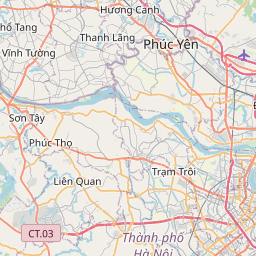





Guide Name: Hanoi Introduction Walking Tour
Guide Location: Vietnam » Hanoi (See other walking tours in Hanoi)
Guide Type: Self-guided Walking Tour (Sightseeing)
# of Attractions: 11
Tour Duration: 2 Hour(s)
Travel Distance: 4.0 Km or 2.5 Miles
Author: Caroline
Sight(s) Featured in This Guide:
Guide Location: Vietnam » Hanoi (See other walking tours in Hanoi)
Guide Type: Self-guided Walking Tour (Sightseeing)
# of Attractions: 11
Tour Duration: 2 Hour(s)
Travel Distance: 4.0 Km or 2.5 Miles
Author: Caroline
Sight(s) Featured in This Guide:
- Temple of Literature
- National Museum of Fine Arts
- Flag Tower of Hanoi
- Imperial Citadel of Thăng Long
- Ho Chi Minh Museum
- One Pillar Pagoda
- Ho Chi Minh Mausoleum
- Ba Dinh Square
- Presidential Palace
- Quan Thanh Temple
- Tran Quoc Pagoda
1) Temple of Literature (must see)
The Temple of Literature, dedicated to the Chinese Philosopher is one of Hanoi’s oldest structures. There are many temples of literature across Vietnam but the Hanoi temple is the oldest and the most important among them. It is also the venue of the country’s earliest university.
The Temple of Literature was founded by Emperor Ly Thanh Tong in 1070 a few years after the establishment of the city of Hanoi. The University established six years later admitted children from the royal family and students from the families of Mandarins. In 1484, Emperor Le Thanh Tong erected steles to record the achievements of students who were awarded doctorates by the university. It ceased to function in 1802 when it was shifted to a new venue.
The temple has five courtyards with boundary walls. Two courtyards have trees, some of which are over a hundred years old. One courtyard has a pond surrounded by sheltered pavilions and steles with details of students who earned doctorates at the university. The Courtyard of the Sage Sanctuary has a building called the Great House of Ceremonies. The house has a large red lacquer figure of Confucius. The last courtyard called the Thai Hoc has a two storey building honoring the founders of the university. There are two square structures on either side of the building to house a drum and a bell.
The Temple of Literature is open from Tuesdays to Sundays and visitors can find mementoes to take home at the souvenir and craft shops near the Great House of Ceremonies.
The Temple of Literature was founded by Emperor Ly Thanh Tong in 1070 a few years after the establishment of the city of Hanoi. The University established six years later admitted children from the royal family and students from the families of Mandarins. In 1484, Emperor Le Thanh Tong erected steles to record the achievements of students who were awarded doctorates by the university. It ceased to function in 1802 when it was shifted to a new venue.
The temple has five courtyards with boundary walls. Two courtyards have trees, some of which are over a hundred years old. One courtyard has a pond surrounded by sheltered pavilions and steles with details of students who earned doctorates at the university. The Courtyard of the Sage Sanctuary has a building called the Great House of Ceremonies. The house has a large red lacquer figure of Confucius. The last courtyard called the Thai Hoc has a two storey building honoring the founders of the university. There are two square structures on either side of the building to house a drum and a bell.
The Temple of Literature is open from Tuesdays to Sundays and visitors can find mementoes to take home at the souvenir and craft shops near the Great House of Ceremonies.
2) National Museum of Fine Arts
The Hanoi Fine Arts museum is a repository of the art and cultural heritage of Vietnam. It has exhibits from the Bronze Age to contemporary works by modern artists. Many of the exhibits are reproductions of artifacts lost during the Indochina Wars.
The Hanoi Museum of Fine Arts is housed in a beautiful colonial building. The architecture of the building is a combination of classical European style with native Vietnamese details. At first the building was a school for girls belonging to families of high ranking officers in the colonial government. Later the building was used by the French Ministry of Information.
The ground floor of the museum has ancient artifacts. There are many sandstone sculptures from the Champa and the Funan Kingdoms. The evolution of the art of lacquer in Vietnam is beautifully depicted at the museum. The second floor has twentieth century paintings by Vietnamese artists including unique lacquer based paintings. The new wing of the museum has Chinese watercolors on the first floor and the second floor has costumes and decorative arts of the different Vietnamese ethnic groups. The most fascinating exhibit is the, ‘One Thousand Eye, One Thousand Arm Guan Yin’, a sculpture of a Hindu Goddess backed by a disk into which one thousand arms are carved.
There are souvenir shops selling paintings and other gift articles in the elevated walkway from the old museum to the new wing.
The Hanoi Museum of Fine Arts is housed in a beautiful colonial building. The architecture of the building is a combination of classical European style with native Vietnamese details. At first the building was a school for girls belonging to families of high ranking officers in the colonial government. Later the building was used by the French Ministry of Information.
The ground floor of the museum has ancient artifacts. There are many sandstone sculptures from the Champa and the Funan Kingdoms. The evolution of the art of lacquer in Vietnam is beautifully depicted at the museum. The second floor has twentieth century paintings by Vietnamese artists including unique lacquer based paintings. The new wing of the museum has Chinese watercolors on the first floor and the second floor has costumes and decorative arts of the different Vietnamese ethnic groups. The most fascinating exhibit is the, ‘One Thousand Eye, One Thousand Arm Guan Yin’, a sculpture of a Hindu Goddess backed by a disk into which one thousand arms are carved.
There are souvenir shops selling paintings and other gift articles in the elevated walkway from the old museum to the new wing.
3) Flag Tower of Hanoi
The 200 year old Flag Tower of Hanoi is not only a symbol of Hanoi but has been declared a world heritage site. The tower was one of the few ancient monuments that the French colonists did not destroy and served as a military watchtower during the colonial period. It also survived the American bombing raids in the 1970s.
The construction of the Flag Tower or the Cot Co tower began in 1805 and was completed in 1812 during the reign of Gia Long, the best known ruler of the Nguyen dynasty. It was the last of the structures added to Gia Long’s citadel. The pyramidal structure has three tiers. The first is 42.5 meters wide and 3.1 meters high, the second is 25 meters wide and 3.7 meters high and the third is 12.8 meters wide and 5.1 meters high. The Vietnamese flag is mounted on a flag pole at the top of the tower. Two staircases are located near the northern door. The second tier has four doors in each direction.
Visitors are allowed to climb the tower and the top floor is an eight sided room with eight windows. The room has enough space for six people to stand and take in the breathtaking views. The tower is lighted by 36 flower shaped and 6 fan shaped windows.
The construction of the Flag Tower or the Cot Co tower began in 1805 and was completed in 1812 during the reign of Gia Long, the best known ruler of the Nguyen dynasty. It was the last of the structures added to Gia Long’s citadel. The pyramidal structure has three tiers. The first is 42.5 meters wide and 3.1 meters high, the second is 25 meters wide and 3.7 meters high and the third is 12.8 meters wide and 5.1 meters high. The Vietnamese flag is mounted on a flag pole at the top of the tower. Two staircases are located near the northern door. The second tier has four doors in each direction.
Visitors are allowed to climb the tower and the top floor is an eight sided room with eight windows. The room has enough space for six people to stand and take in the breathtaking views. The tower is lighted by 36 flower shaped and 6 fan shaped windows.
4) Imperial Citadel of Thăng Long
The Imperial Citadel of Thăng Long in Hanoi is a noteworthy historical site representing various eras of Vietnamese history. Originally constructed in 1011 by Emperor Lý Thái Tổ, the founder of the Lý dynasty, this imperial complex has witnessed the evolution of Vietnam's dynastic rule through the centuries. The Citadel, initially established in the early 11th century, served as the political center of the country for almost 800 years.
Over the years, the Citadel was expanded and modified by subsequent dynasties, including the Trần, Lê, and Nguyễn. Each dynasty contributed to its grandeur, reflecting the changing architectural and cultural tastes of the periods. However, by 1810, the Nguyễn dynasty moved the capital to Huế, which marked the beginning of the decline of the Thăng Long Citadel as the center of political power.
By the late 19th century, during the French conquest of Hanoi, the Citadel had fallen into disrepair. Many of its historic structures were severely damaged or destroyed in the subsequent decades. It wasn't until the 21st century that significant archaeological efforts began to systematically excavate and preserve the ruins of this once majestic imperial city.
A significant but grim chapter in the Citadel’s history occurred in mid-1945 when it was used by the Imperial Japanese Army to detain over 4,000 French colonial soldiers during the Japanese coup d'état in French Indochina.
Recognition of the site's historical and cultural significance came on July 31, 2010, when UNESCO designated the central sector of the Imperial Citadel of Thăng Long as a World Heritage Site. This honor highlights the importance of the site not just to Vietnamese heritage but to the world, acknowledging its rich historical layers that offer insight into the cultural and political developments in Vietnam over the millennia.
Over the years, the Citadel was expanded and modified by subsequent dynasties, including the Trần, Lê, and Nguyễn. Each dynasty contributed to its grandeur, reflecting the changing architectural and cultural tastes of the periods. However, by 1810, the Nguyễn dynasty moved the capital to Huế, which marked the beginning of the decline of the Thăng Long Citadel as the center of political power.
By the late 19th century, during the French conquest of Hanoi, the Citadel had fallen into disrepair. Many of its historic structures were severely damaged or destroyed in the subsequent decades. It wasn't until the 21st century that significant archaeological efforts began to systematically excavate and preserve the ruins of this once majestic imperial city.
A significant but grim chapter in the Citadel’s history occurred in mid-1945 when it was used by the Imperial Japanese Army to detain over 4,000 French colonial soldiers during the Japanese coup d'état in French Indochina.
Recognition of the site's historical and cultural significance came on July 31, 2010, when UNESCO designated the central sector of the Imperial Citadel of Thăng Long as a World Heritage Site. This honor highlights the importance of the site not just to Vietnamese heritage but to the world, acknowledging its rich historical layers that offer insight into the cultural and political developments in Vietnam over the millennia.
5) Ho Chi Minh Museum
This museum is dedicated to the life and times of Vietnam’s founding father, Ho Chi Minh. The museum has five floors full of memorabilia belonging to or related to the great leader of North Vietnam. It was opened on the 2nd September 1990, a hundred years after the birth of Ho Chi Minh.
The building housing the Ho Chi Minh museum combines Vietnamese architectural elements with Russian architectural styles. The facade has a large relief of the hammer and the sickle. Exhibits in the museum include military orders, photographs, memorabilia of the October and August revolution, the struggle for independence and the many movements led by Ho Chi Minh. The top floor has a large metal sculpture of a lotus flower in gold and many objects relating to the revolutionary leader. A labyrinth of murals tells the story of Vietnam from past struggles to future hopes. National totems surround a bright red volcano that symbolizes the Vietnamese revolutionary movement. It has a library, a large hall, meeting rooms and research rooms.
The museum stays open from Tuesdays to Thursdays and on weekends. Bags and cameras are not allowed and visitors are required to follow a strict dignified dress code and maintain silence while viewing exhibits.
The building housing the Ho Chi Minh museum combines Vietnamese architectural elements with Russian architectural styles. The facade has a large relief of the hammer and the sickle. Exhibits in the museum include military orders, photographs, memorabilia of the October and August revolution, the struggle for independence and the many movements led by Ho Chi Minh. The top floor has a large metal sculpture of a lotus flower in gold and many objects relating to the revolutionary leader. A labyrinth of murals tells the story of Vietnam from past struggles to future hopes. National totems surround a bright red volcano that symbolizes the Vietnamese revolutionary movement. It has a library, a large hall, meeting rooms and research rooms.
The museum stays open from Tuesdays to Thursdays and on weekends. Bags and cameras are not allowed and visitors are required to follow a strict dignified dress code and maintain silence while viewing exhibits.
6) One Pillar Pagoda
Located in the Ho Chi Minh Mausoleum complex in Hanoi, this temple is dedicated to the Goddess of mercy and protector of children, Quan Am. The structure gets its name because the wooden temple is supported by a single pillar.
The temple was built in 1049 by King Ly Thai Tong who ruled from 1028 to 1054. According to legend, Quan Am came in a dream seated on a lotus and handed a male child to the childless emperor. Soon after, he married a peasant girl and a male child was born. The pagoda dedicated to Quan Am was built like a lotus rising from the water by the emperor after the birth of the child. The French forces destroyed the temple in 1954 during the First Indochina War. The temple was rebuilt in 1955 with a concrete pillar replacing the old stone pillar on which the original pagoda stood.
A flight of narrow steps lead to the small shrine where a gilded figure of Quan Am sits upon lotus blossoms. Locals worship at the temple for fertility and good health and the smell of incense permeates the building. Visitors are required to cover their legs before entering the temple. There is a small snack stand that sells refreshments for the convenience of visitors as they take in the beauty of the pagoda and its exquisite natural surroundings.
The temple was built in 1049 by King Ly Thai Tong who ruled from 1028 to 1054. According to legend, Quan Am came in a dream seated on a lotus and handed a male child to the childless emperor. Soon after, he married a peasant girl and a male child was born. The pagoda dedicated to Quan Am was built like a lotus rising from the water by the emperor after the birth of the child. The French forces destroyed the temple in 1954 during the First Indochina War. The temple was rebuilt in 1955 with a concrete pillar replacing the old stone pillar on which the original pagoda stood.
A flight of narrow steps lead to the small shrine where a gilded figure of Quan Am sits upon lotus blossoms. Locals worship at the temple for fertility and good health and the smell of incense permeates the building. Visitors are required to cover their legs before entering the temple. There is a small snack stand that sells refreshments for the convenience of visitors as they take in the beauty of the pagoda and its exquisite natural surroundings.
7) Ho Chi Minh Mausoleum
Ho Chi Minh wrote in his will that he wanted his body to be cremated and the ashes strewn all over Vietnam because it was hygienic and valuable land would not be wasted. The people of Vietnam willed otherwise. They wanted their leader to remain a living symbol of their many struggles against foreign powers. The result was this imposing mausoleum where his body lies embalmed.
The Ho Chi Minh mausoleum built with the help of the USSR is modeled on the mausoleum of Lenin in Moscow. It is a large granite square structure, 21.6 meters high and 41.2 meters wide. Ho Chi Minh’s embalmed body lies in the cooled central hall of the mausoleum. An armed guard protects the body enclosed in a glass case with dim lights. There is an impressive change of guard every day. In autumn, every year, the body is flown to Moscow for maintenance.
The gardens surrounding the mausoleum are in the form of 240 squares with specific boundaries. There are 250 species of plants and flowers from the different regions of Vietnam and bonsais of indigenous trees. The words, ‘nothing is more precious that independence and freedom are engraved on the stone façade of the mausoleum.’
The mausoleum is a place of reverence for the Vietnamese people and strict disciplinary codes are enforced. Visitors are required to cover their legs, maintain silence and their hands cannot be crossed or in their pockets. Photography and smoking are not allowed.
The Ho Chi Minh mausoleum built with the help of the USSR is modeled on the mausoleum of Lenin in Moscow. It is a large granite square structure, 21.6 meters high and 41.2 meters wide. Ho Chi Minh’s embalmed body lies in the cooled central hall of the mausoleum. An armed guard protects the body enclosed in a glass case with dim lights. There is an impressive change of guard every day. In autumn, every year, the body is flown to Moscow for maintenance.
The gardens surrounding the mausoleum are in the form of 240 squares with specific boundaries. There are 250 species of plants and flowers from the different regions of Vietnam and bonsais of indigenous trees. The words, ‘nothing is more precious that independence and freedom are engraved on the stone façade of the mausoleum.’
The mausoleum is a place of reverence for the Vietnamese people and strict disciplinary codes are enforced. Visitors are required to cover their legs, maintain silence and their hands cannot be crossed or in their pockets. Photography and smoking are not allowed.
8) Ba Dinh Square
Located in the heart of Hanoi is the Ba Dinh Square that bore witness to many of the turbulent events in the history of Vietnam. It is a large square located in front of the Mausoleum of Ho Chi Minh where gatherings and festivities are held.
Ba Dinh square is 320 meters long and 100 meters wide. It has the capacity for a gathering of over 20,000 people. The square is divided into 240 green spaces. President Ho declared the independence of Vietnam on the 2nd of September 1945 at the square. After 24 years thousands gathered at the same place to mourn the death of Ho Chi Minh. Several main arteries of Hanoi branch off from Ba Dinh Square including the 1000 meter Xiong Wang Road.
Many important buildings flank the Ba Dinh square. Notable among them are the Presidential Palace, Ho Chi Minh’s house and the museum in his honor and the thousand year old, One Pillar Pagoda. There is also a monument for those who laid down their lives for the independence of Vietnam. Important events and parades take place at the square through the year.
Visitors can make Ba Dinh square the starting point to visit many of the attractions in Hanoi. In the morning, locals perform Tai Chi exercises at the square and at night locals gather to stroll or hang out with their friends.
Ba Dinh square is 320 meters long and 100 meters wide. It has the capacity for a gathering of over 20,000 people. The square is divided into 240 green spaces. President Ho declared the independence of Vietnam on the 2nd of September 1945 at the square. After 24 years thousands gathered at the same place to mourn the death of Ho Chi Minh. Several main arteries of Hanoi branch off from Ba Dinh Square including the 1000 meter Xiong Wang Road.
Many important buildings flank the Ba Dinh square. Notable among them are the Presidential Palace, Ho Chi Minh’s house and the museum in his honor and the thousand year old, One Pillar Pagoda. There is also a monument for those who laid down their lives for the independence of Vietnam. Important events and parades take place at the square through the year.
Visitors can make Ba Dinh square the starting point to visit many of the attractions in Hanoi. In the morning, locals perform Tai Chi exercises at the square and at night locals gather to stroll or hang out with their friends.
9) Presidential Palace
The Presidential Palace in Hanoi was built as the residence of the Governor General under French colonial rule. Today it is used as a guest house and reception facility for foreign dignitaries.
The Presidential Palace is a yellow three storey building constructed in Renaissance and Beaux Art style. The French colonial rulers had a civilizing mission and believed that European architectural styles were superior to traditional Asian housing design. The building has no Asian architectural feature. It was built in 1900 by Auguste Henri Vildieu, who was the official architect of Vietnam. The building stands behind strong wrought iron gates with sentry boxes on either side.
The palace is surrounded by expansive grounds including an alley with mango trees that leads to a humble structure on stilts occupied by Ho Chi Minh. After independence, Ho Chi Minh refused to live in the presidential palace and chose to stay in the servant’s quarters till his small cottage was constructed in the grounds. The cottage called uncle Ho’s cottage or the Nha San Bac Ho, is designed like the traditional houses in North West Vietnam that offered shelter to revolutionaries during their struggle for independence from the French rulers.
The presidential palace is off limits to visitors but the grounds and the cottage of Ho Chi Minh can be viewed for a small fee.
The Presidential Palace is a yellow three storey building constructed in Renaissance and Beaux Art style. The French colonial rulers had a civilizing mission and believed that European architectural styles were superior to traditional Asian housing design. The building has no Asian architectural feature. It was built in 1900 by Auguste Henri Vildieu, who was the official architect of Vietnam. The building stands behind strong wrought iron gates with sentry boxes on either side.
The palace is surrounded by expansive grounds including an alley with mango trees that leads to a humble structure on stilts occupied by Ho Chi Minh. After independence, Ho Chi Minh refused to live in the presidential palace and chose to stay in the servant’s quarters till his small cottage was constructed in the grounds. The cottage called uncle Ho’s cottage or the Nha San Bac Ho, is designed like the traditional houses in North West Vietnam that offered shelter to revolutionaries during their struggle for independence from the French rulers.
The presidential palace is off limits to visitors but the grounds and the cottage of Ho Chi Minh can be viewed for a small fee.
10) Quan Thanh Temple
Located on the shore of the Truc Bach lake in Hanoi is the Quan Thanh, an 11th-century Taoist temple dedicated to Tran Vu, a principal Taoist deity. The temple was built during the reign of King Li Thai To, between 1010 and 1028. Since then, the structure has undergone several renovations. The last restoration of the temple was in 1893.
Tran Vu was one of the four deities that protected Hanoi in each direction. The role of Tran Vu was to protect the north of the city. According to legend the deity helped King An Duong Vuong chase away demons during the construction of the Co Loa citadel. From the principal gate visitors can see the three door entrance of the temple with a bell tower and the figure of a tiger that is said to guard the pagoda. A large bronze statue of Tran Vu by master sculptor, Old Trong sits majestically within the shrine. A statue of Old Trong carved in his honor by grateful students is also found in the temple.
The Quan Thanh pagoda is a major tourist attraction in Hanoi. Locals visit the temple on the Lunar New Year and on the 1st and 15th of the Lunar month to pray for health, luck and happiness. Traditional martial arts classes are held near the temple.
Tran Vu was one of the four deities that protected Hanoi in each direction. The role of Tran Vu was to protect the north of the city. According to legend the deity helped King An Duong Vuong chase away demons during the construction of the Co Loa citadel. From the principal gate visitors can see the three door entrance of the temple with a bell tower and the figure of a tiger that is said to guard the pagoda. A large bronze statue of Tran Vu by master sculptor, Old Trong sits majestically within the shrine. A statue of Old Trong carved in his honor by grateful students is also found in the temple.
The Quan Thanh pagoda is a major tourist attraction in Hanoi. Locals visit the temple on the Lunar New Year and on the 1st and 15th of the Lunar month to pray for health, luck and happiness. Traditional martial arts classes are held near the temple.
11) Tran Quoc Pagoda
The Tran Quoc Pagoda, located on a small peninsula between the West Lake and Truc Bach Lake in Hanoi, is the oldest pagoda in Vietnam. It was constructed in the 6th Century, during the reign of Emperor Ly Nam De, who was also called the Khai Quoc ( National Founder).
The Tran Quoc pagoda is built in the tradition of the Indian Stupa. It is a tall, tower like structure where religious relics were placed for veneration. The architecture used for the pagoda itself and surrounding structures is in harmony with nature and adds to the natural setting without disturbing the scenery. The ancient pagoda underwent extensive restoration in 1815. It now has a triple gate, sitting room, an ancestor worship chamber and a garden tower. The ancient corridors, ten shrines and a belfry are carefully preserved. The pagoda has many statues including a lacquer and gold statue of the Buddha and many steles including a stele depicting the history of the Pagoda by Nguyen Xuan Chinh crafted in 1639. The Bodhi tree in the gardens, grafted from the original Bodhi tree under which the Buddha attained enlightenment, was a gift from the Government of India during the visit of their first president in 1959.
The Tra Quoc Pagoda is a cultural symbol of Vietnamese Buddhism and remains a place of pilgrimage. International visitors are required to follow a strict dignified dress code and men and women are expected to cover their legs when visiting the temple.
The Tran Quoc pagoda is built in the tradition of the Indian Stupa. It is a tall, tower like structure where religious relics were placed for veneration. The architecture used for the pagoda itself and surrounding structures is in harmony with nature and adds to the natural setting without disturbing the scenery. The ancient pagoda underwent extensive restoration in 1815. It now has a triple gate, sitting room, an ancestor worship chamber and a garden tower. The ancient corridors, ten shrines and a belfry are carefully preserved. The pagoda has many statues including a lacquer and gold statue of the Buddha and many steles including a stele depicting the history of the Pagoda by Nguyen Xuan Chinh crafted in 1639. The Bodhi tree in the gardens, grafted from the original Bodhi tree under which the Buddha attained enlightenment, was a gift from the Government of India during the visit of their first president in 1959.
The Tra Quoc Pagoda is a cultural symbol of Vietnamese Buddhism and remains a place of pilgrimage. International visitors are required to follow a strict dignified dress code and men and women are expected to cover their legs when visiting the temple.
Walking Tours in Hanoi, Vietnam
Create Your Own Walk in Hanoi
Creating your own self-guided walk in Hanoi is easy and fun. Choose the city attractions that you want to see and a walk route map will be created just for you. You can even set your hotel as the start point of the walk.
Hanoi's Old Quarter Walking Tour
The Old Quarter (Vietnamese: Phố cổ Hà Nội) is the name commonly given to the historical civic urban core of the city, located outside the Imperial Citadel of Thăng Long in the northern half of Hoàn Kiếm District, renowned for its small street blocks and alleys, and a traditional Vietnamese atmosphere.
During the Lê dynasty (1428-1789), the area included several lakes and wetlands... view more
Tour Duration: 2 Hour(s)
Travel Distance: 4.0 Km or 2.5 Miles
During the Lê dynasty (1428-1789), the area included several lakes and wetlands... view more
Tour Duration: 2 Hour(s)
Travel Distance: 4.0 Km or 2.5 Miles
The Most Popular Cities
/ view all

